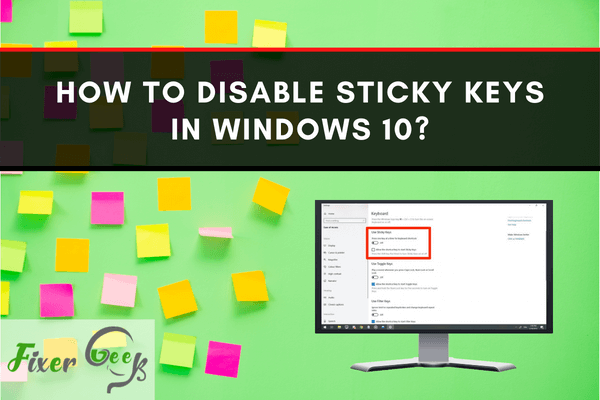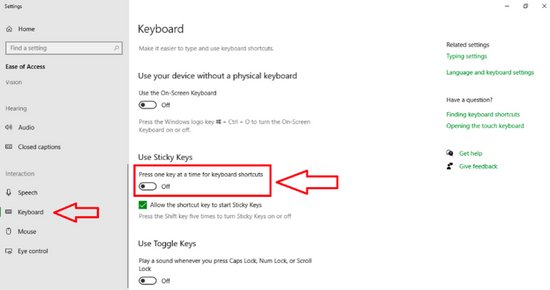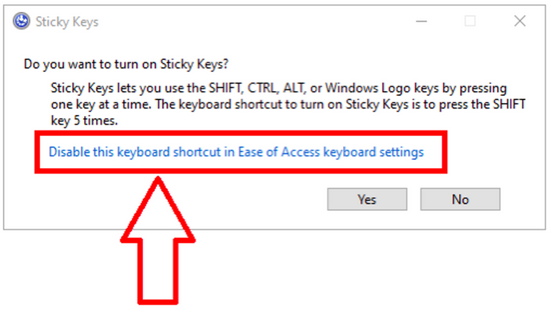Microsoft is continuously striving to improve the technology behind its products and services, including Windows 10. Although some of these improvements are major changes, others are quite minor but useful. One of the most recently introduced features is a pause before the “Press any key” prompt appears on your screen. If you use sticky keys for controlling windows, and find yourself accidentally triggering the introduction of this new feature in Windows 10, here’s how you can disable it.

Windows 10 operating system is full of features that aim to ease the user with its operation. The operating system uses a wide array of shortcut keys that enable the user to access necessary apps, programs, or features quickly. However, some features, while helpful to others, are irritating or annoying to others.
The Sticky Keys feature is designed to make the keyboard more accessible, especially to users with impairments or those avoiding repetitive strain injuries. This is not an entirely new feature for graphical user interfaces because as it was in 1988 when Mac OS System Software 6 launched Sticky Keys.
Instead of pressing multiple keys simultaneously, Sticky Keys allows the user to press multiple keys (e.g., Shift, Ctrl, Alt) at once using a designated key. Windows 95 (released 1995) was the first Microsoft operating system to feature Sticky Keys.
Sticky Keys are normally disabled by default. However, should you encounter a situation in which Sticky Keys are enabled, here are some ways to turn off Sticky Keys:
Sticky Keys Taskbar Icon
- While Sticky Keys are activated (you can check the taskbar icon as shown in the screenshot), press Shift five times. A short whining sound will be played as the feature turns off.

- Access the Settings app (as a shortcut, press Windows key + I [press the Windows key first then without releasing it, press the I key immediately]), look for the Keyboard settings on the left tab, and once the keyboard settings have been loaded, click the slide bar to turn off Sticky Keys.
However, the keyboard shortcut option to enable Sticky Keys may remain. It could annoy the user, especially in situations where pressing the Shift key multiple times in a row is necessary. For example, some games require pressing the Shift key multiple times to trigger an action, which unfortunately also causes the Sticky Keys dialog box to pop up.
Here’s how to disable the Sticky Keys pop-up box
- Spam the Shift key (i.e., press it five times) to trigger the Sticky Keys dialog box.

- Click the option that lets you use the Ease of Access keyboard option to deactivate the keyboard shortcut in the dialog box (as shown in the above screenshot).
- Untick the options that let you use the shortcut key to twitch Sticky Keys, as shown in the screenshot above. This will disable the pop-up dialog box from being activated by the Shift key.
For older Windows versions such as Windows 7, or Vista, steps and Control Panel options are similar with slight differences in phrasing and access options.
To re-enable the shortcut key, follow the steps discussed in the section detailing the pop-up box's disabling, but this time, tick the option that lets the Sticky Key start with the shortcut key. This will enable the shortcut key. Press the Shift key multiple times to show the pop-up box and click “Yes” to activate Sticky Keys.
Summary: Disable Sticky Keys in Windows 10
- Press the Windows key on your keyboard to open the Start menu.
- Select Settings.
- In the search box, type Ease of Access keyboard settings and press Enter.
- Click Sticky Keys to open it.
- Turn off Turn on Sticky Keys by unchecking Enable Sticky Keys.
- Click OK and close out of the window.
Conclusion
Sticky Keys is just one of the numerous accessibility options Windows offers for users with impairments. Pressing the Windows key + U on the keyboard will show the Ease of Access center. This center has all the different accessibility options and features for users with impairments.